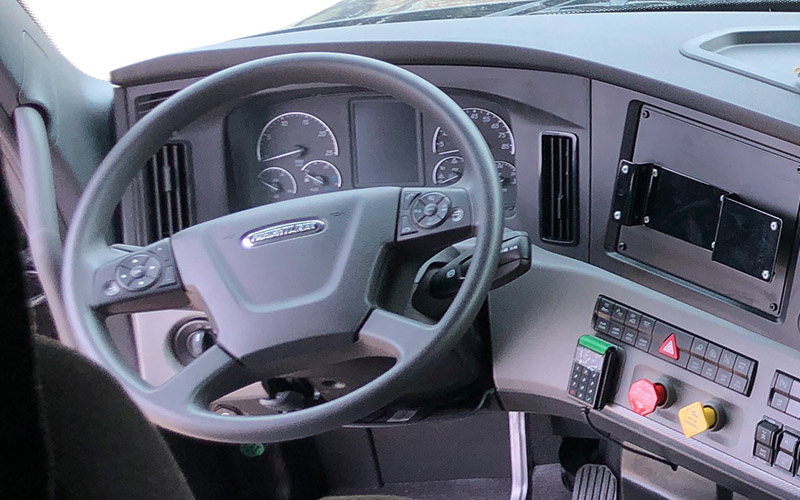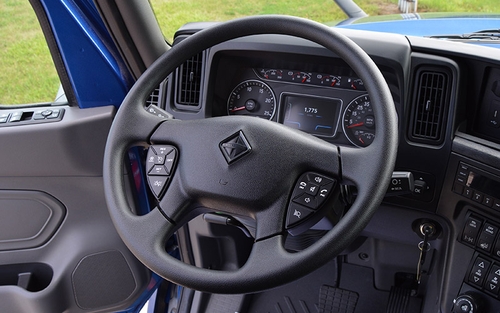How many gears does a semi-truck have? What you should know


By The Schneider Guy
Estimated reading time: 2 minutes
When it comes to the mechanics of semi-trucks, one of the most frequently asked questions revolves around their transmission system. Particularly, people often wonder, "how many gears does a semi-truck have?"
Here, we won’t only go into the number of gears a semi-truck has, but also break down how it’s determined and why it’s important.
How many gears do semis have?
Semi-trucks, also known as tractor-trailers or 18-wheelers, are designed to haul large loads over long distances. To do this, they are equipped with transmissions that have a higher number of gears compared to passenger vehicles.
The number of gears a semi has varies based on the make, model and specific use of the truck. Most semi-trucks have either 10, 13 or 18 gears. While they can have anywhere from eight to 18 gears, these are the most common configurations to see.
Why do semi-trucks need so many gears?
Passenger vehicles typically have only five or six gears, so why do semi-trucks need so many? The simple answer is power and efficiency.
Semi-trucks must balance the power needed to haul heavy loads and the efficiency needed for long-distance travel. Having so many gears allows for the usage of the most appropriate gear for the engine's power output at any given moment:
- In a lower gear, more torque is provided to the wheels. This is useful for starting up the truck, climbing steep inclines and hauling heavy loads.
- In a higher gear, the wheels turn faster, even though the engine is at the same revolutions per minute (rpm) as in a lower gear. This reduces fuel consumption and engine wear, which is useful for highway driving and maintaining consistent speeds.
The wide range of gears allows for several other benefits, including:
Gradual acceleration
Given their significant weight, especially when fully loaded, semi-trucks need a way to gradually work up to speed. Having multiple gears allows for smoother acceleration and more control over the vehicle.
The many gears a semi-truck has are needed to get the best use of the engine at lower rpm. Diesel engines achieve peak horsepower at much lower rpm than gasoline engines. A diesel engine may reach peak horsepower at 600-700 rpm and maintain that power up to 1800 rpm, whereas cars have a redline (maximum rpm) of 6000-7000 rpm.Fuel efficiency
Operating a truck within the best rpm range for its engine maximizes fuel efficiency. More gears mean the engine can stay closer to its ideal rpm, optimizing fuel usage and reducing costs.
It’s not only about the gears or engine size, though. The rear-end gearing also determines rpm and fuel economy when hauling heavy loads. This is why many larger companies go with an all-around middle gear ratio and heavy haul companies go with lower gear ratios.Reduced wear and tear
By allowing the engine to run within its optimal range, wear and tear on the engine is minimized. Having more gears helps prolong the life of the truck.
Terrain management
Climbing and descending hills requires precision control of speed to maintain safety. Having a wider range of gears helps manage this.
What determines the number of gears a semi-truck has?
The number of gears on a semi-truck can vary based on several factors. Some of the most important are:
Fuel efficiency
Since fuel is one of a carrier's highest costs, minimizing that cost with fuel efficient combinations of engine, transmission and rear-end is among the most important factors to consider when ordering a truck.
What is being hauled.
The purpose of the truck and the loads it hauls can dictate the type of transmission necessary. Trucks hauling heavier loads require more gears to efficiently operate across flat plains and climb hills without sacrificing speed or fuel efficiency.
That said, many carriers have semi-trucks that are spec’d to haul a variety of freight. At Schneider, most of our semi-trucks have 12-speed automated manual transmissions. The same truck pulls a variety of loads, with total weight ranging from 31,000 to 80,000 pounds.
The terrain.
The terrain a truck drives on plays a crucial role in determining the number of gears needed. Routes featuring steep gradients or rugged terrain need a broader range of gears to handle the ascents and descents.
Want to learn about Schneider’s semis?

Schneider Guy loves the "Big Orange." He's passionate about the trucking industry and connecting people to rewarding careers within it. He's been the eyes and ears of our company since our founding in 1935, and he's excited to interact with prospective and current Schneider associates through "A Slice of Orange."



